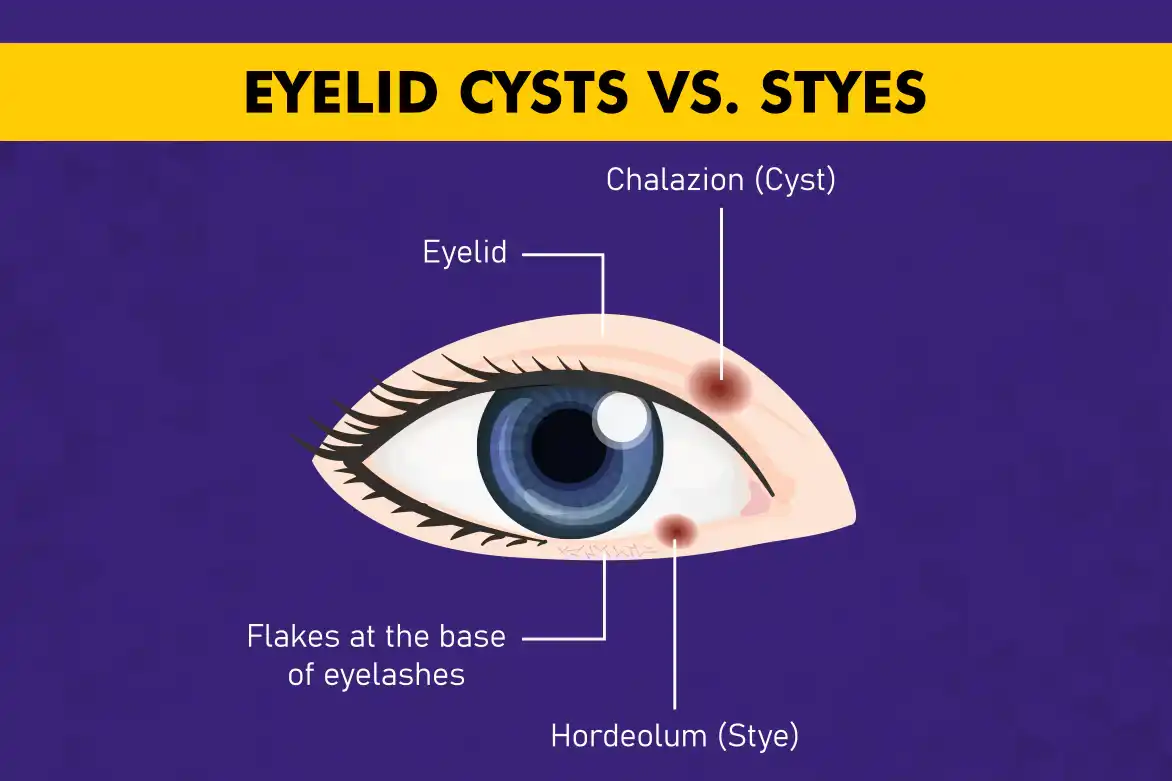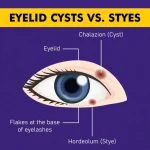Eyelid cysts and styes are very common and can affect individuals of all ages in India. While both conditions might appear similar at first glance, they are, in fact, quite different. Many people find it difficult to tell them apart due to overlapping symptoms like swelling or discomfort in the eyelid. However, understanding the differences between these two can help manage them effectively. This blog aims to help you differentiate between cysts and styes and offers guidance on what to do if you experience either condition.
What Are Eyelid Cysts?
An eyelid cyst, commonly called a chalazion, is a painless lump that forms due to the blockage of an oil gland in the eyelid. When these glands, known as meibomian glands, become obstructed, they can cause fluid buildup, forming a cyst. Unlike styes, cysts typically develop further from the edge of the eyelid and are less painful. The lump may grow gradually and create a swelling that occasionally affects vision if left untreated.
Many cysts often resolve on their own over time. In some cases, they may persist and may benefit from treatment. Applying warm compresses and gentle massages can sometimes help promote drainage. For larger or more persistent cysts, medical options, such as steroid injections or a minor procedure, may be considered to assist with removal.
What Are Styes?
A stye, or hordeolum, is an infection of an eyelash follicle or oil gland, usually caused by bacteria like Staphylococcus aureus. Styes are typically red, painful, and located along the edge of the eyelid, often resembling a small pimple or boil. Unlike the painless nature of cysts, styes can be quite tender to the touch and may cause swelling and irritation in the surrounding area.
Styes often resolve on their own within a few days as they drain naturally. However, if a stye does not improve or begins to cause increased discomfort, medical treatment may be beneficial to ensure proper healing. Sometimes, a doctor’s support in draining the stye may be recommended.
Cyst vs. Stye – Key Differences.
| Feature | Eyelid | Styes |
| Pain | Usually painless | Often painful and tender |
| Location | Further from the lash line, inside the eyelid | Near or along the lash line, on the outer surface |
| Appearance | Smooth, swollen lump | Red, pimple-like, with a boil-like head |
| Causes | Blocked oil glands (chalazion) | Bacterial infection (hordeolum) |
Causes of Eye Cysts.
Eyelid cysts are commonly caused by underlying conditions like blepharitis or rosacea. These conditions can lead to gland blockage and fluid retention, resulting in cyst formation. Understanding the causes of eye cysts helps in managing these conditions effectively. The symptoms of an eye cyst typically include a painless, smooth lump on the eyelid, which can gradually swell. These cysts are usually located further from the edge of the eyelid.
What Causes Styes in Adults?
Styes occur when bacteria infect the oil glands or hair follicles of the eyelid, causing inflammation and swelling. Symptoms of stye include redness, pain, and a pimple-like lump near the eyelid edge. The causes of stye include poor eyelid hygiene, touching the eyes with dirty hands, or excessive oil production. It’s important to note that styes can be contagious, as they stem from bacterial infections. Knowing what causes eye styes can help in prevention and proper care.
When to See a Doctor.
It’s important to know when to seek medical attention for eye cysts and styes. For cysts, see a doctor if you notice symptoms such as the cyst growing larger, causing persistent swelling, or beginning to obstruct your vision. A healthcare professional can evaluate whether further treatment, such as draining the cyst or administering steroid injections, is necessary.
For styes, seek medical advice if the pain becomes significant and the stye is increasing. Recognising symptoms of stye, like increased redness and pus formation, is important for timely care. While most styes improve on their own, in some instances, they may lead to more significant issues that could require medical attention, such as antibiotics or a minor procedure to relieve discomfort and promote healing.
Home Remedies and Treatments.
For both eyelid cysts and styes, home remedies can be very effective:
Warm Compress: Applying a warm compress several times daily can help soothe the affected area, promote drainage, and speed up healing. This is beneficial for both cysts and styes.
Gentle Massage: For cysts, gently massaging the area can encourage the gland to unblock and help the cyst resolve more quickly.
Hygiene Tips: Keeping the eyelids clean is essential to prevent styes. Wash your hands before touching your eyes, and avoid rubbing them.
Over-the-counter treatments like antibiotic ointments for styes or steroid injections may be useful for large eyelid cysts. And in some rare cases, minor surgery might be required to drain a cyst or stye that doesn’t respond to other treatments.
Preventing Eyelid Cysts and Styes.
Prevention is key to avoiding the recurrence of eyelid cysts and styes. Here are some practical tips:
Eyelid Hygiene: Regularly clean your eyelids using cleansing wipes or a gentle baby shampoo to reduce the buildup of oils and bacteria.
Avoid Touching Eyes: Refrain from rubbing your eyes, especially with dirty hands, as this can transfer bacteria to the eyelids and trigger infections.
Replace Eye Makeup: Ensure you regularly replace eye makeup, such as mascara and eyeliner, to avoid bacterial contamination. Never use expired makeup.
Maintaining proper eyelid hygiene and taking preventive measures can significantly reduce the risk of developing both eyelid cysts and styes.
Distinguishing between eyelid cysts and styes is essential for proper treatment and care. Both conditions can be treated with home remedies like warm compresses, but medical intervention may sometimes be required. You can manage or prevent these common eyelid problems by following hygiene tips and addressing symptoms early. If you’re unsure about the nature of your eyelid issue, it’s always best to consult a healthcare professional.
FAQs
How do you get rid of a cyst on your eyelid?
A warm compress can help an eyelid cyst drain naturally. If it persists, medical treatment, such as steroid injections or incision and drainage, may be required.
Are eyelid cysts permanent?
Eyelid cysts are usually not permanent and resolve on their own. Persistent cysts, however, may need medical/surgical intervention.
What’s the difference between a cyst and a stye?
A cyst is a painless lump caused by blocked oil glands forming away from the lash line. A stye is painful, red, and forms near the eyelid edge due to a bacterial infection, often resembling a pimple.
How serious is a cyst in your eye?
Eyelid cysts are typically not severe but can obstruct vision or become infected, requiring treatment if they persist.
How do I get rid of a stye overnight?
A warm compress can speed up the healing of a stye. However, styes often take a few days to heal, even with treatment.
Are eye styes caused by stress?
Stress can lower immunity, increasing the chance of getting a stye, but bacterial infections primarily cause styes.
Why do people get styes?
Styes form due to bacterial infections, often from touching the eyes with unwashed hands or poor eyelid hygiene.





